Quick Tips:
Speed limit alerts: Comprehensive speed alerts for all of
Australia and New Zealand are available on the iPhone as part of
the Metroview
Navigator app . Also available from Google
Play. Speed limits are part of the offline navigation maps
that have a good route guidance, if needed. The Metroview
settings allow the user to select the levels of warning. I find
that an audible warning at 3km/h over the limit allows me to
easily drive within the speed limit. With this enabled you can
turn off speed camera alerts. Importantly Metroview works
with Carplay and it can run in the background so you can
receive speed alerts while running another navigator app in
Carplay. Seems a good $9.99 investment to me! For NSW
drivers there is also the Transport for NSW - Speed
Adviser - free
smartphone app.
Manual speed limiter: Many modern cars
have a manual speed limiter. The driver selects an appropriate
maximum speed and it is then easy to stay within the speed limit.
For example, Volvos have a very easy way to activate and
deactivate the system: simply press the left arrow to place in
stand-by mode (not actually described in the diagram below) and
press the centre button (or resume button) to activate the speed
limiter at the current speed. Use the up and down arrows to
increase or decrease the chosen speed in 5km/h increments (or
press an hold for 1km/h increments). Press the centre button (or
press accelerator pedal to floor) to deactivate the speed limiter.
Unfortunately the latest EuroNCAP/ANCAP protocols assign the most
points for intelligent speed assistance and some manufacturers are
not incorporating a simple manual speed limiter in the system.

Alerts
Includes (italics) publications
authored & co-authored by Michael Paine and also some of
his presentations.
2025 Global NCAP: Intelligent Speed
Assistance: The Transformational Technology for Improved Speed
Management
2024 The Conversation: Lower
speeds on local streets cut deaths and injuries by a quarter in
Wales. Over 100 experts want Australia to do the same + Open
Letter
2023 India Today: You
can now use Google Maps to avoid speed challan, here is how
- Google Maps is enhancing road safety and preventing
unintentional speeding with a new real-time speed limit feature
2023 27th ESV ADAS
in your pocket – a review of the features, functions and
future of smartphone-based advanced driver assistance systems
- potential for highly cost-effective crash reductions through
smartphone apps
2022
Euro NCAP Vision 2030
- see page 9 for planned updates to Speed Assist Systems
2022 ETSC: Opinion:
will Intelligent Speed Assistance (ISA) live up to its
promise? [I agree with Graziella that the EU regulations
have missed a great opportunity to implement ISA that is
accurate and does not annoy drivers]
2021 ETSC: Intelligent
Speed Assistance specifications officially published (by
EU)
2021 CASR - new reports: The
contribution of various levels of speeding to fatal and
serious road trauma - "The results suggest that low
level speeding is not benign and should remain the focus
of various road safety interventions, along with all levels of
speeding" + Collection
and analysis of EDR data from crash-involved vehicles: 2020-21
summary report
2021
European Transport Safety Council: iSAFER - Intelligent
Speed Assistance for European Roads
2021
CASR: Intelligent
Speed Adaptation (ISA): benefit analysis using EDR data from
real world crashes - lower predicted savings than previous
estimates but still very substantial
2020
AAP: Impact
speed and the risk of serious injury in vehicle crashes -
based on the study described in the ESV paper
2019 ESV:
Speeding in crashes in the United States of America: A pilot
study using event data recorder information from NASS-CDS
(co-author with CASR)
2019:
ETSC: European
Parliament backs new vehicle safety standards - including
overridable Intelligent Speed Assistance.
2017
Global NCAP: Report
of the Seminar on Advancing Speed Assistance Systems
(updated URL) + Michael
Paine's slide show.
2017
ETSC: Global
NCAP looks to boost take-up of speed assistance systems
worldwide
2013:
23rd ESV conference: DEVELOPMENT
OF AN ASSESSMENT PROTOCOL FOR AFTER-MARKET SPEED LIMIT
ADVISORY DEVICES -& + NEW
NCAP TEST AND ASSESSMENT PROTOCOLS FOR SPEED ASSISTANCE
SYSTEMS, A FIRST IN MANY WAYS
2012: Old Ideas plus New Technology Equals
Crash Savings - Global Road Safety Partnership conference,
Bangkok
2012: Pay-How-You-Drive
car insurance will reward drivers who obey speed
limits
2012::
SpeedAlert Live was
available for free for iPhone
and Android.(Update
2015: vanished from App Store)
2012::
ISA in the USA: 5 Dec 12 IIHS Status Report: Intelligent
speed adaptation devices can reduce speeding.
2009:
First
International Conference on Intelligent Speed Adaptation:
Sydney 10 Nov 2009.
2009:
Low Range Speeding and the Potential
Benefits of Intelligent Speed Assistance (600K PDF
preprint of conference paper) - findings confirmed in
Casualty
crash reductions from reducing various levels of speeding
(2011 CASR report)
2009:
Speed
limiting trials in Australia - 21st ESV
2007:
What's hot in road safety? Vehicles
that obey the speed limits - ACRS Seminar,
2007: In-vehicle
Intelligent Speed Advisory Systems - 20th ESV
2004:
Presentation
on
speed control at the WHO Road Safety Day in Sydney.
2003:
Presentation to Staysafe on Speed
Control
1998:
Why consider speed control devices for
vehicles
1996: Speed Control Devices for Cars -
research report for NSW government
Pioneering SAS products
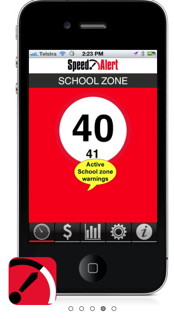
2007 Review of the world's first passive
ISA navigator device with a national speed limit database
- the Navig8r M35 with SpeedAlert™ 99% of the time I do NOT need a navigator map. 100%
of the time I DO need speed limit information.This little unit displays the
speed limit and beeps if you creep over the speed limit by
more than a selected amount (e.g. 2km/h). It has a
SpeedAlert mode where only speed limit information is
displayed and no map - reducing distraction. The built-in
speed limit database covers most populated areas of
Australia. I have successfully used SpeedAlert in Sydney,
Perth, Adelaide, Melbourne, Canberra, Wollongong, Newcastle
and Brisbane.
2008
Beware of some brands of sat-nav that have a speed limit sign
displayed on the packaging. The speed limit database is very
limited for some devices (eg around schools and speed cameras)
or, worst still, has to be set manually by the driver. To my
knowledge only the SpeedAlert system has an extensive
nationwide database and time-based school zones.
Update June 2009: The latest Navig8r - the G35 has the option
for an analogue speedo display -
a dynamic speedo that clearly shows the current speed
limit. I also like the scale of the speedo, with a maximum speed
of 120km/h. Video of demonstration (10Mb WMV)
2010: Speed alerts are
available on the iPhone as part of the Metroview
Navigator app . The SpeedAlert app (illustrated at right)
is no longer availble. The Sygic
app has speed advisory features.
2016:
Transport for NSW - Speed
Adviser - free smartphone app.
Oct 2021 update: Updated to the latest speed zones
• Updated to the latest non-standard school zones
• Updated to the latest non-standard school times
• Updated school and public holiday calendar
Note that all of the in-car speed limit advisory systems that I
have tested fail to give reliable school zone information. See DEVELOPMENT
OF AN ASSESSMENT PROTOCOL FOR AFTER-MARKET SPEED LIMIT
ADVISORY DEVICES
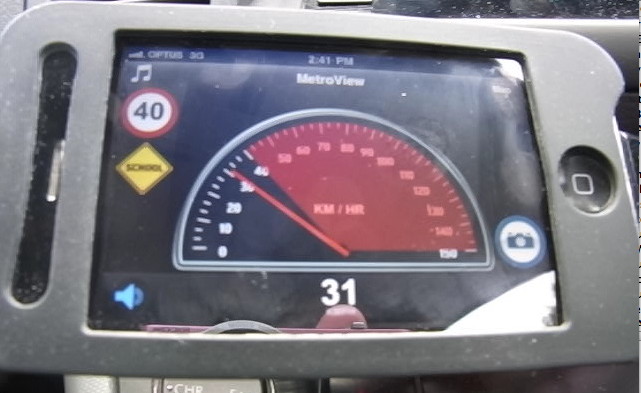
2011 - SpeedAlert still
available in a low-cost sat-nav
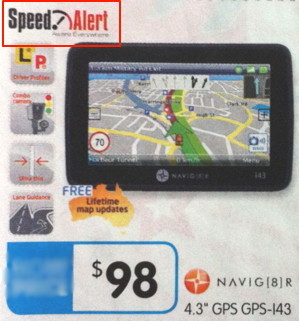
Post-publication
notes, news and links
I first became
aware of the remarkable road safety benefits of reducing traffic
speeds while researching a project for the NSW Roads and Traffic
Authority in 1996: Speed
Control Devices for Cars. Subsequent presentations have
included:
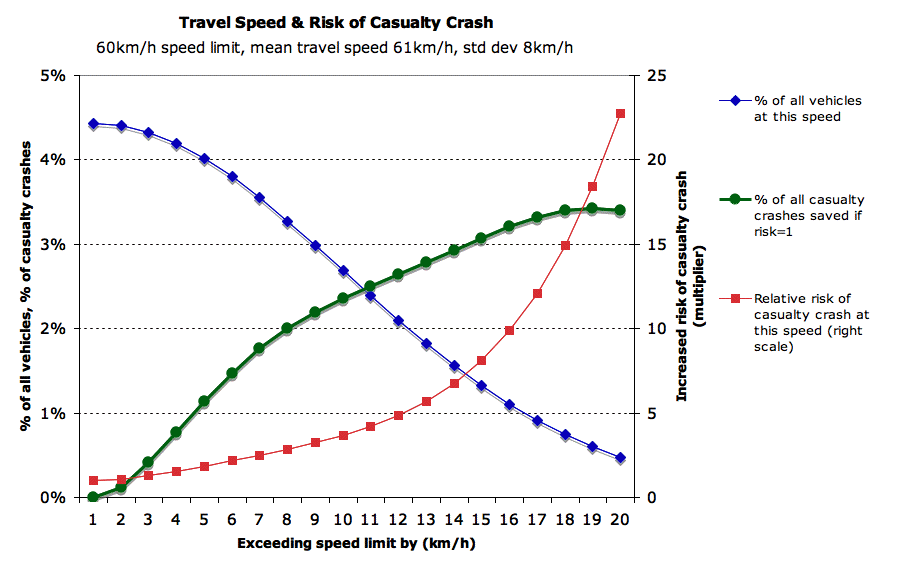
Two key points that motorists should be aware of are:
1. Half of all
fatal accidents occur at an impact
speed of less than 55km/h. "Low speed" collisions can
be deadly. This is due to Newton's physics and the frailty of
the human body.
2. Every 5km/h above the speed limit doubles the risk of being
involved in a casualty accident. In a 60 zone, travelling at
65km/h doubles the risk and travelling at 70km/h quadruples
the risk.
For several years I have been calling for measures that assist
motorists comply with speed limits (and, incidentally, avoid
speeding tickets). GPS navigation technology is bringing that
closer to reality.
One of the key findings is that, for a given
set of road conditions, there is a optimum maximum speed, above
which the risk of fatal accidents can be expected to rise more
or less exponentially. This risk is largely due to restricted
sight distances and the corresponding time available to
recognise that a hazard is present and decide to take avoidance
action - the risk is not greatly affected by driver ability
or vehicle braking performance.
Separate lines of road safety research have produced the similar
conclusions:
- Swedish research (Nilsson
1993) into speed limit changes throughout the
developed world suggests a fourth power relationship between
mean traffic speed and the proportion of fatal crashes. A 3%
reduction in mean traffic speeds can produce a 12% reduction
in fatal crashes.
- Recent analysis, by the Insurance Institute for
Highway Safety , of speed limit changes within some
states in the USA shows a 15% increase in fatalities per
vehicle kilometre travelled for states that have increased
speed limits. FAQ
on speed.
- The NHMRC Road Accident Research Unit
has prepared a report Travelling
Speed and the Risk of Crash Involvement which found
that in a 60km/h speed limit area, the risk of involvement
in a casualty crash doubles with each 5km/h increase in
travelling speed above 60km/h
The clear message is that it is very
important that speed limits are set, and enforced, according
to the actual conditions so that they do not exceed the
optimum level for those conditions, otherwise a
disproportional increase in fatalities can be expected. It is
not advisable to set speed limits according to the speeds
perceived as "safe" by motorists (for example, 85th percentile
traffic speeds) - given suitable input, "expert" computer
systems are a much better way to decide on appropriate speed
limits - see
Big Brother?
There is no surveillance used in the ISA system, which is under
trial in several countries. GPS is simply used by the system
WITHIN THE VEHICLE to determine its geographic location. A
digital map then provides the driver with the posted speed
limit. No one but the driver knows the location and speed of the
vehicle (although, with some systems, trips can be recorded for
later analysis).
9 Feb 09 Canberra Times (reprint): A
new attitude to speeding needed.
Response to the article and comments...
The problem is that most motorists
do not appreciate the extra risks involved in travelling just
a few km/h over the speed limit. Most think that the risk of a
casualty crash is doubled if you a travelling at least 25km/h
over the speed limit. The truth, which is based on the
unbreakable laws of physics and the frailty of the human body,
is that in urban areas the risk is doubled for each 5km/h over
the limit. So travelling at 70km/h in a 60 zone quadruples the
risk of a crash in which someone is hospitalised. As a result,
about 15% of road fatalities could be prevented if the (large)
group of motorists who routinely travel at up to 10km/h over
the limit were encouraged to obey the speed limits.
It is difficult, if not impossible, for enforcement methods
like fixed speed cameras to have an effect on this "minor"
speeding. An added problem is that even motorists who want to
obey the speed limits (to keep their life, licence or
livelihood) have difficulty doing this in modern cars on city
roads. This is where Intelligent Speed Assist comes into its
own. The system has a very simple function, backed up by very
clever technology. It knows the location and speed of the
vehicle and, from an on-board database of speed limits, it can
alert the driver to speeding. I have been using an ISA device
in Sydney since mid 2006 and have prepared papers for
international road safety conferences. Participants at these
conference often express disbelief that Australia is leading
the world with this technology. Sometimes they claim there
could be negative outcomes, such as always driving at the
speed limit rather than to the conditions, but numerous ISA
trials around the word have shown these claims are
unsubstantiated.
Yesterday the Sunday papers in Sydney had a Harvey Norman
brochure advertising the Navig8r M35 unit for $148. This unit,
as described by Crispin, can be run exclusively in speed alert
mode displaying just the speed limit and current vehicle
speed. This avoids the distraction of the navigation map,
which is rarely needed for regular driving (the map is
instantly available by touching a button the screen but I
would like to see any sat-nav device require the vehicle to be
stationary before it accepts any touch screen input).
In my view, every novice driver should be issued with such an
intelligent speed assist device for the first year of driving.
Maybe the resulting responsible driving would rub off on the
rest of us.
"The first reaction to something that
challenges your beliefs is denial" - Rev
Thomas Goodhue.
Links to ISA projects
around the world
Australasia
[Legacy] Products described on the
Internet (for information - not endorsement)
Updates and news (most recent at bottom)
- 28 May 1998: Prof Murray Mackay from the
University
of
Birmingham has estimated that the "delta V" for the
crash which killed Diana, Princess of Wales, was about
80km/h - not double this speed as originally speculated by
the media. Note this was an offset crash so the intrusion
was greater than if the crash forces had been distributed
across the full width of the vehicle (or absorbed by a
safety barrier!).
- In January 1999 the New South Wales
Government introduced 40km/h speed limits for motorists when
passing buses picking up or setting down school children.
See '
Flashing Warning Lights for School Buses' for
background on this issue.
- In December 1999 the NSW Government
issued Road
Safety 2010 which has speed management as a key
strategy.
- March 2000: There has be a promising
development on this issue in the UK: The executive report
for 'phase 2' of a speed limiter project is now available at
http://www.its.leeds.ac.uk/projects/evsc/index.html
- Dr (now Prof) Carsten was in the media a
few months ago over the issue of GPS data being used to
determine local speed limits (the media picked up the item
as satellites spying on speeding cars - which is nonsense!).
Phase 2 involved on road trials of adaptive speed limiters,
driver simulator work and computer simulations of traffic
flow effects. It all looks very promising. For example they
predict a 20% reduction in road crashes and an 8% reduction
in fuel consumption with 'mandatory' speed limiters (ie
vehicle unable to exceed the posted speed limit).
- April 2000: MUARC
is also conducting a trial of speed limiters in Melbourne,
using GPS technology. MUARC has summaries of several related
reports: The
Speed Review, Speed
behaviour..., Vision
Zero...,
- August 2000: IIHS(PDF)
and NHTSA
HTML (or PDF)
issue reports (in May 2000 and Oct 1999) showing the link
between vehicle travel speeds and pedestrian injuries.
- Feb 01: French invention: A.C.S. - speed Sensitive
Accelerator Pedal.
- 1 Mar 01: Intelligent Speed
Management - German initiative (updated URL).
- 3 Oct 01: Swedish ISA
project - 5000 vehicles in trials across Sweden.
- 13 Mar 02 : Paper on the TAC
Safer
Car project now available from Road Safety 2001
conference.
- 26 Nov 02 SMH: Assume
the
position -- new technology pinpoints radar, cameras and
more. First step towards Intelligent Speed Adaption. Blackspot.com.au.
- 9 Aug 03 Staysafe: Speed
and
motor vehicles - inquiry by NSW parliament road safety
committee - submissions sought.
- 21 Oct 03 : Presentation
to
Staysafe on Speed Control - 13 Oct 03 (800K pdf)
- 26 Oct 03: Prof Carsten's 2001 ESV paper
Intelligent
speed
adaptation: the best collision avoidance system (PDF).
This paper covers many of the issues associated with
introducing this technology.
- 19 Nov 03 ICBC: Unsafe
speed and aggressive driving campaign kick-off - has
an excellent video.
- 25 Nov 03 NYT: Study
Links
Higher Speed Limits to Deaths (regn) - IIHS Status
Report "Faster
Travel" (PDF)
- 11 Dec 03 Action Imports: Carminder
System - uses GPS and mobile phone system to give
vehicle location and speed to a caller.
- 19 Mar 04 NewSci: Vibrating
pedal
says 'ease off gas'.
- 22 Mar 04 Austroads:
A
Review of Literature and Trials of Intelligent Speed
Adaptation Devices for Light and Heavy Vehicles (PDF)
- 7 Apr 04: Presentation on speed control
and DRLs at WHO road safety day (PDF)
- 1 May 04: Roadsense is an
Australian website opposed to speed cameras - but the
statistics have been misunderstood (see conference papers
below).
- 10 May 04 Auto Insider: Guidepoint
[GPS]
system helps locate stolen vehicles (and more)
- 16 May 04 SAE Highway Vehicle Event Data Recorder Symposium
June 3-4, 2004, Ashburn, Virginia, USA
- 19 Jun 04 AAP: Effects
of
an active accelerator pedal on driver behaviour and
traffic safety after long-term use in urban areas
(abstract) - compliance
with the speed limits improved considerably. Reduction in
average speeds and less speed variation by the test
vehicles indicate a great traffic-safety potential. Travel
times were unaffected, while emission volumes decreased
significantly.
- 1 Sep 04 SMH Drive: Remote
control
(more big brother nonsense)
- 3 Oct 04 New Scientist: READING
THE
SIGNS Drivers may soon have to come up with a
better excuse than “Sorry officer, I didn’t know I was
speeding” thanks to a new electronic device that can
recognise passing road signs, such as speed limits, and warn
drivers not to ignore them.
- 20 Oct 04 Australian Transport Safety
Bureau brochure (PDF): Impact
speed - Will you stop in time?
- 5 Nov 04 Fleet News: Study
puts
brakes on speeding fleet drivers
- 3 Feb 05 BBC: Clever
cars taking to the road - Parents, says Mr Illsley, might be interested in
a vehicle that they can set the upper speed for,
especially if they have teenage sons who are eager to get
behind the wheel.
- 21 Feb 05 AAP: Would
relaxing
speed limits aggravate safety?: A case study of Hong Kong
- The relaxation of the
speed limit from 70 to 80 km/h increased the Fatal+Serious
accident counts by 36%.
- 7 May 05 ETSC report: The
Safety
of Vulnerable Road Users in the Southern, Eastern and
Central European Countries - recommends expediting
intelligent speed adaptation.
- 9 May 05 Fleet News: Speed
cameras
fail to cut road deaths - more correctly the road toll
has not changed much (but other factors like mobile phone
use confound the issue).
- 27 Jun 05 CNN: System
reads
speed limits for drivers
- 1 Jul 05 AAP (abs): Intelligent
speed
adaptation: accident savings and cost–benefit analysis.
- 3 Aug 05 AAP (abs): Are
speed
enforcement cameras more effective than other speed
management measures? An evaluation of the relationship
between speed and accident reductions.
- 9 Dec 05 CNN: Device
stops
speeders from inside car - "discovered" by North
America some 8 years after Europe and Australia! Otto Driving Companion
(product)
- South Australian Dept Transport: 50
km/h speed limit – The Facts.
- 23 May 06 IIHS Status Report: Bad
statistics leads to misinformation
- 12 May 06 New Scientist (subs): How
to kick the habit - Well, there is a quick fix. In one decisive act,
the government could save in excess of 50 million gallons
of gasoline..[55mph national speed limit - which
would also save 1000s of lives. Note that every minute saved
by travelling at excessive speed is matched by a one minute
reduction in life expectancy of somebody in the community
due to increased risk of a fatal accident].
- 20 May 06 NHTSA: Analysis
of Speeding-Related Fatal Motor Vehicle Traffic Crashes
- In 2002, 13,713
fatalities -- about a third of all fatalities that
occurred in motor vehicle traffic crashes were
speeding-related, i.e., at least one of the drivers
involved in the crash was speeding. Figure 19 gives
strong reasons to top-speed limit motorcycles!
- 31 May 06 BREAKTHROUGH: Speed Alert - PDA
or mobile phone displays speed zones and alerts driver to
speeding and school zones - Sydney covered in inital
release. Aug 06: Now on sale.
- 15 Jun 06 LiveScience: New
In-Car Device Warns Speeding Drivers.
- ATSB: Beliefs
and Attitudes about Speeding and its Countermeasures -
May 06
- 9 Aug 06 Fleet News BREAKTHROUGH: British
Gas opts for speed limiters - BRITISH Gas is demanding
manufacturers fit speed limiters to its fleet of more than
10,000 vans in a bid to ensure its drivers remain safe on
the road.
- 30 Jan 07 Question:
Half of all fatal car accidents occur at or below what
impact speed?
- New Zealand Accident Compensation
Corporation: Down
with Speed.
- 28 Feb 07 ETSC (published May 2006): Intelligent
Speed Assistance - Myths and Reality.
- 28 Feb 07 Thinking Highways: Adapt
to Survive. (thanks John Gill)
- 21 Sep 07 FleetNews: Speed
limiter plan to make roads safer.
- 7 Nov 07 Wikipedia
entry on ISA.
- 9 Jan 08 Brisbane Courier Mail: Move
to speed-limit fast cars
- 13 Jan 08 SMH: Big
Brother speed control to be trialled - not sure where
the "Big Brother" came from, or my title as "Queensland
Transport Consultant"! + News.com: Secret
car speed-limiter trials.
- 14 Jan 08 ACRS 07: Demonstration
of Advisory Intelligent Speed Adaptation Technology in
Western Australia - excellent review of current trials
and developments
- Regan, M., Triggs, T., Young, K.,
Tomasevic, N., Mitsopoulos, E., Stephan, K., and Tingvall,
C. (2006). On-Road Evaluation of Intelligent Speed
Adaptation, Following Distance Warning and Seatbelt Reminder
Systems: Final Results of the Australian TAC SafeCar
Project. Volume 1: Report. Monash University Accident
Research Centre Report
253. MUARC: Melbourne, Australia
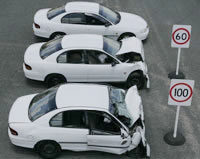
- 1 May 08: NSW
RTA Speed Page now has a crash
test video showing a recent model car crashing at
60km/h and 100km/h + 40
& 50 km/h speed limits on NSW roads
- 1 May 08 ETSC: Lower
speeds: Win-Win for Road Safety and the Environment
+ Managing
Speed: Towards Safe and Sustainable Road Transport:
- Adopt European legislation for
mandatory fitting of European cars with informative or
supportive Intelligent Speed Assistance systems in the
type approval procedure for cars. This Directive should
include technical requirements and an implementation
timetable.
- As a first step, promote the
industry’s efforts by supporting additional research and
standardisation, by introducing tax cuts as incentives
to install ISA and becoming first customers of ISA
technology. As a second step, require informative or
supportive Intelligent Speed Assistance systems by law.
Authorities in charge of the road network management
should, possibly in co-operation with the private
sector, develop a digital database of all the speed
limits on the network and make this
database available for GPS application as a prerequisite
to the implementation ISA systems.
- 13 May 08 [UK] Daily Mail: Satnav
that tells you not to break the speed limit
- 2 Jun 08 Boston.com: As
fuel prices rise, some speedometer needles fall.
- 3 Jun 08 ABC: Perth
motorists nation's worst for speeding: survey.
- 16 Jun 08 IIHS Status
Report, Vol. 43, No. 1 - Speed (PDF)
- 25 Jun 08 SMH: Big
brother satellites to put brakes on speeders + NZH: High-tech
backseat driver set for trials + ABC: Speed-limit
device trialled in cars + LiveNews:
Big Brother's under your hood: Govt trials new speed
tracker + Gold Coast: Cars
to trial Big Brother speed control. [Comment: There is
no "Big Brother" watching/tracking the cars - the system
uses GPS to determine the road and speed and an on-board
digital map of speed limits]. RTA: ISA
webpage - with Flash video
- 1 Aug 08 CNet: Sat-navs
set to nag about speed limit.
- 8 Aug 08 Transport Canada: Heavy
Truck Speed Limiter Reports.
- 16 Sep 08 Uk Telegraph:
Drivers could have speed limited by satellite devices
- 17 Sep 08 Express: NEW
'BIG BROTHER' CONTROL ON ALL CARS TO STOP SPEEDING
(opinion: It is a pity that organisations like RAC and AA do
not do a little homework before coming out with misinformed
criticisms)
- 17 Sep 08 UK DfT: Intelligent
Speed Adaptation (ISA) - project reports
- 13 Oct 08 ABC South Australia:
'Creeping' motorists targeted - Motorists who drive
several kilometres an hour over the speed limit are being
targeted in a State Government road safety campaign.
- 17 Dec 08 ACRS: Heavy
vehicle speed management - policy paper (Doc) - [ISA]
technologies, either acting separately or in tandem, have
significant potential to assist operators to comply with
speed limits, meet Occupational Health and Safety
obligations while potentially reducing greenhouse gas
emissions and improving business profitability.
- 18 Dec 08 Drive: Red
alert on speeding - The (passive ISA) device can be
purchased now as a satellite navigation unit for $249 - or,
from February, downloaded to any GPS-enabled mobile phone or
PDA (personal digital assistant) for a monthly subscription
of $9.90.
- 31 Dec 08 Financial Times: Advisers
urge fast action on speed limiters - Fitting cars with
speed controllers could cut road injuries by a quarter and
reduce air pollution... + Commission for Integrated
Transport: Speed
limit adherence and its effect on road safety and climate
change.
- 31 Dec 08 Moldova: Nissan
debuts world's first intelligent cruise control -
Utilizing route-information fed through the on-board
navigation system, the Intelligent Cruise Control system can
modulate the vehicle-speed in anticipation of the next curve
on the road [but no mention of ISA]
- 15 Jan 09 European Commission: The
when, where, why of road accidents - The greatest
additional benefits – a 6-10% improvement in terms of
injuries – are expected from speed adaptation systems [note
that the estimated ESC benefits are highly dependent on
local conditions and are unlikely to be realised in
Australia]
- 5 Mar 09 The Citizen (UK): Lancashire
drivers to test new 'road safety sat navs
- 7 May 09 SpeedAlert: Would
you like to help us Beta trial one of the most
revolutionary Speed Limit Awareness software products in
Australia?
- 11 May 09 Times: Speed-curbed
cars launched in Government trial + Taxis
and buses face automatic speed limiting + Telegraph: Speed-restricted
car: a review.
- 12 May 09 BBC: Speed
limit device tested on bus + Autocar: Speed
limiter tests in London
- 14 May 09 Transport Briefing: TfL
urges sat-nav makers to embrace ISA technology
- 19 May 09 Daily Telegraph: NSW
plan for speed limiters in all cars.
- 23 Sep 09 Apple iTunes/Sygic: Intelligent Speed Assistance
function now available for the Apple iPhone. Does not
currently handle school zones.
- 16 Oct 09 Australian
Mining: VDO launches Speed Alert to handle varying speed
limits (not the same as SpeedAlert)
- Nov 09: Low
Range Speeding and the Potential Benefits of Intelligent
Speed Assistance (600K PDF preprint of
conference paper). 12% of casualty crashes would
be saved if those who regularly drive between 2 and
10km/h over the speed limit obeyed the speed limits.
Fatality savings would be much higher.
- 16 Dec 09 Drive: Melbourne
driver stuck on cruise control - Comment: Cruise
control forces
the vehicle to travel at a minimum speed unless there
is driver intervention (or the system fails - in this case
the brake pedal signal to the ECU appears to have
failed and so braking did not deactivate the cruise control.
To make matters worse, by design, the ignition could not be
turned off and the transmission could not be
changed!). Many fatigue-related crashes in outback
Australia involve the driver falling asleep when cruise
control is engaged. Active ISA can replace cruise
control as a way of maintaining an appropriate speed on the
open road and has significant road safety benefits.
- 14 Jan 10 The Age: GPS
tool to warn speeding drivers (note that the Navig8r G35 sat-nav
already has SpeedAlert.
Also the greatest benefits of ISA will come from a reduction
in inadvertent speeding) + Herald Sun: Hoon
drivers to be used in test of government's new GPS speed
device.
- 17 Apr 10 ETSC: Safety
Monitor April 2010 - Speed is the most important
contributory factor to road deaths and injuries, playing a
role as a contributing factor in one third of all fatal
collisions. Speeding remains extremely widespread, it is
estimated that at any one moment about 35% of drivers exceed
speed limits outside built-up areas and as much as 50% in
urban areas.
- 5 May 10 ANE: Vans,
light trucks face [top] speed limiters in EU - to
prevent them exceeding 120 km per hour...
- 25 Oct 10 Daily Telegraph: Calls
for anti-speeding beep test by RTA. RTA
research report.
- 21 Dec 11 CASR: Advisory
Intelligent Speed Adaptation for government fleets -
ISA was found to have the potential to reduce casualty
crashes in government fleets by 20%.
- 21 Dec 11 EconPapers: An
Energy and Emissions Impact Evaluation of Intelligent
Speed Adaptation.
- 21 Dec 11 ATRF 2011: Analysis
of a financial incentive to encourage safer driving
practices.
- 21 Dec 11 PRAISE: Driving
for Work and Managing Speed
- 25 Jun 12 Drive: $25
[a week] not to speed - financial reward
virtually eliminates speeding in US study.
- 5 Sep 12 Mix Telematics:
Managing
driver speed.
- 5 Sep 12 India Today: Government
plans pre-fitted GPS devices on vehicles to check speed
- 4 Dec 12 Foxbusiness: Will
Insurers Soon Pay us Not to Speed? See also Pay-How-You-Drive car
insurance
- 5 Dec 12 IIHS Status Report: Intelligent
speed adaptation devices can reduce speeding.
- 18 Feb 13 Accident Analysis &
Prevention, Volume 52 ($): Fractions
of fatal crashes attributable to speeding: Evolution for
the period 2001–2010 in France - future policy should
focus on low and medium-level speeding in order further to
reduce road deaths significantly, since these levels now
correspond to the major fraction of fatal crashes.
- 3 Jul 13 CarSafetyRules: Euro
NCAP wants Speed Assist tech to help drivers control
speeding DEVELOPMENT
OF AN ASSESSMENT PROTOCOL FOR AFTER-MARKET SPEED LIMIT
ADVISORY DEVICES - 23rd ESV (2013)
- 27 Jul 13 Royal Institution of Australia:
Low
level speeding.
- 1 Nov 13 Land Transport NZ: Research
Report 521 An investigation into the deployment of an
advisory ISA system in New Zealand (thanks Ian Faulks)
- 9 Jul 14 ETSC: Intelligent
Speed Assistance ‘most effective’ driver support system
- 20 Aug 14 BBC: Google's
driverless cars designed to exceed speed limit [by up
to 10mph] - a stunning admission when the safety of these
vehicles is under scrutiny.
- 14 Nov 14 ETSC: Safety
as Standard dinner debate for members of European
Parliament in Brussels + ISA
- the Research Evidence by Prof Oliver Carsten
- 14 Nov 14 ResearchGate: Do
motorists really intend to speed in school zones? + Where
drivers don’t mean to speed, it’s no good just fining them
(thanks Ian Faulks)
- 28 Jan 15 ETSC:
- 30 Oct 15 ETSC: Opinion: Has
ISA’s time finally come? + ISA-fitted
cars start to hit showrooms: "The first vehicles with
this kind of ISA system factory fitted started appearing on
the market this year – helped in part by Euro NCAP’s
decision to reward extra points for vehicles that include
ISA…While much of the hype in the media these days is
concerned with autonomous vehicles, ETSC believes that
policymakers should not focus their regulatory eyes too far
in the future. Semi-automated systems already available and
approved for use have the potential to save many lives
today. They should make sure that ISA, together with other
proven technology such as Intelligent Seat Belt Reminders
and Automated Emergency Braking, are fitted as standard as
soon as possible.” "The latest version of Ford’s S-Max and
Galaxy, and Volvo’s XC90 can come factory-fitted with camera
and GPS-based systems that alert the driver to the current
speed limit and help prevent him or her from exceeding it.
The systems can be activated and deactivated by the driver
using steering wheel controls in a similar way to existing
manual speed limiter and cruise control systems.”
- 2 Nov 15 AAP ($): Speeding
in urban environments: Are the time savings worth the
risk? - "The results show that the average driver
saves 26 s/day or 2 min/week by speeding. More importantly,
the cost of these time savings is one fatality for every
24,450 h saved by the population on 100 km/h roads in dry
conditions and one injury for every 2458 h saved on the same
roads. Full speed compliance – and consequently a dramatic
reduction in the road toll – could be achieved through
almost imperceptible increases in travel time by each
driver."
- 14 Nov 15 EU: Benefit
and
feasibility of a range of new technologies and unregulated
measures in the field of vehicle occupant safety and
protection of vulnerable road users (ISA may become
mandatory in Europe under rulemaking being considered in
2016)
- 14 Apr 16 Austroads: Achieving
Safe System Speeds on Urban Arterial Roads: Compendium of
Good Practice
- 14Apr 16 IIHS: Speed
limit increases cause 33,000 deaths in 20 years (PDF)
- 1 Jun 16 ETSC: Ford
says Intelligent Speed Assistance proving popular -
Ford says 95% of customers are opting for its version of
Intelligent Speed Assistance, known as Intelligent Speed
Limiter, to be fitted on new Galaxy and S-Max models sold in
Europe + Telematics
cut speeding by 97% says UK fleet manager - reduced
speeding by 97% and crashes
by 47% as well as reducing maintenance costs and
improving fuel economy + London
to require ISA on all new buses from next year.
- 22 Aug 17 Transportation today: US
should implement new policies to combat motorist deaths
due to excessive speeding, NTSB report says + NTSB: Reducing
Speeding-Related Crashes Involving Passenger Vehicles..."Intelligent
speed
adaptation is an effective vehicle technology to reduce
speeding...Recommendation: Incentivize passenger vehicle
manufacturers and consumers to adopt intelligent speed
adaptation (ISA) systems by, for example, including ISA in
the New Car Assessment Program."
- 3 Nov 17 ETSC: Global
NCAP looks to boost take-up of speed assistance systems
worldwide + Global NCAP: Report
of the Seminar on Advancing Speed Assistance Systems +
Michael
Paine's slide show.
- 1 May 18 ETSC: OECD
study says inappropriate speed responsible for up to 30%
of all fatal crashes + European
Commission set to announce major new road safety package
(Including ISA - 16th May)
- 18 May 18 Stop the Crash: Global
NCAP and Stop the Crash Partnership welcome new EU
regulations on vehicle safety - AEB
and ISA
- 18 Oct 18 ETSC: Car
industry attempting to weaken the European Commission’s
proposals on new vehicle safety measures -
"Intelligent Speed Assistance: why does ACEA not back a
technology currently being sold by a majority of its
members?"
- 11 Jan 19 ETSC: MEPs
back new road and vehicle safety rules - AEB & ISA
to be regulated across Europe
- 8 Apr 19 AutobodyNews: Did
You Know? Speeding Is a Neglected Problem [in the USA]
+ IIHS: Speed
limit increases are tied to 37,000 deaths over 25 years
- 1 Jun 19 Intelligent Transport: Are
you ready to speed up the roll out of intelligent speed
assistance?
- 7 Oct 19 Cision: Western
Express
deploys 3,000 E-SMART units [with ISA] to make its truck
fleet one of the safest and most innovative in the
industry.
- 1 Oct 21 NRSPP: Quick
Fact: Speed.. almost 50% of serious speeding-related
crashes occur when a driver is travelling at less than
10km/h above the posted speed limit"
- 1 Dec 21 Roadsafe:
- 27 Sep 22 Global Fleet: Bad
driving habits could call for new legislation in the US.
- 11 Nov 23 The Conversation: How
to never get a speeding fine again — and maybe save a
child’s life
- 17 Nov 23 UNSW: Need
for speed: why some speedometers lag behind reality -
"...half of all serious crashes involving a vehicle
travelling at five kilometres per hour over the speed limit
would been avoided, or would not have resulted in injuries
or fatalities, if that vehicle had been travelling at the
speed limit."
- 20 Nov 23 India Today: You
can now use Google Maps to avoid speed challan, here is
how - Google Maps is enhancing road safety and
preventing unintentional speeding with a new real-time speed
limit feature
- 20 Nov 23 Drive: "Turn
it off!": This annoying Kia and Hyundai safety feature is
enough to drive you spare!
- 16 Jan 24 Safetywissen: Israel
to require Intelligent Speed Assistance updates for
EU-approved Vehicles - a requirement for ISA to work
with the country's speed limit signs.
- 28 Jul 24 Japan Today: Japan
to reduce speed limit on residential roads to curb accidents.
- 10 Aug 24 The Spinoff: ‘Unjust
and unethical’: The scrap over speed reductions, explained.
- 10 Sep 24 ABC: NSW
government to trial average speed cameras for all vehicles
in bid to curb state's rising road toll
- 2 Dec 24 Fleetnews: [UK] Road
deaths decline but speeding a factor in half of fatalities
- 6 Mar 25 The Conversation: False
economies: the evidence shows higher speed limits don’t make
financial sense.
- 6 Mar 25 Roadsafe (UK): Promoting
Intelligent Speed Assistance to reduce UK road traffic
crashes.
- 1 May 25 ETSC: German
motorway speed limit could save billions.
Related Australasian Road Safety Research, Policing and
Education Conference Proceedings :
Developments in Safer Motor
Vehicles
Conference organised by SAE Australasia and NSW
Parliament
Staysafe
Committee
16-17 March 1998 Parliament House, New South Wales
WHY CONSIDER SPEED
CONTROL DEVICES FOR VEHICLES?
In the recently published NSW road accident
statistics for 1996 it is stated that 38% of all fatal accidents
were speed related. In other words, 38% of all fatal crashes
could have been avoided or made less severe if the vehicle had
been travelling at a more appropriate speed for the
circumstances.
When we think of speed-related accidents we
usually think of high-speed crashes. In fact most fatal
accidents occur at impact speeds well under 70km/h.
SPEED AND
CRASHES
Probability of fatality or serious injury
Figure 1 is based on casualties to seat belt
wearing drivers in car to car crashes in the USA between 1982
and 1991 (Evans, 1993). The probability
of serious injury or death is plotted for a range of impact
speeds (more correctly delta V - the change in velocity).
Notice that the fatal curve rises steeply beyond 60km/h. .![[Prob of injury Vs Impact Speed]](SL_PFI.JPG)
Table 1 Probability of belted driver
being killed or
severely injured in two car
collisions
| Delta V (km/h) |
Prob. of fatality |
Prob. of sev. inj. or fatality |
| 40 |
0.02 |
0.08 |
| 50 |
0.05 |
0.16 |
| 60 |
0.11 |
0.27 |
| 70 |
0.21 |
0.40 |
| 80 |
0.31 |
0.54 |
| 90 |
0.41 |
0.65 |
| 100 |
0.50 |
0.75 |
![[Distribution of
impact speed forbelted driver fatalities]](SL_FREQI.JPG)
Figures 2 shows the frequency distribution
of impact speeds for the same data as the previous figure.
Notice that half of all fatalities to seat-belted drivers
occurred at less than 45km/h. Although the risk of a fatality
is low at these speeds the total number of reported crashes
(including non-injury crashes) in this impact speed range is
much greater than at the higher impact speeds. This suggests
that measures which address impact speeds in the range 30 to
50km/h are just as important as those which address higher
speeds. Remember that these data are for seat belted drivers.
Crash Tests
The Australian New Car Assessment Program
started offset crash testing in 1993. In 1995 the impact speed
for the offset test was raised from 60km/h to 64km/h in line
with international practice. This resulted in a noticeable
difference in crash severity. A speed increase of 6% resulted
in a 13% increase in impact energy.
While advanced features such as airbags can
have a significant influence on the many crashes that occur at
or below the current NCAP test speed it is likely that other
factors, such as structural failure will influence the outcome
of crashes at higher speeds.
These pictures show a vehicle with a
longstanding safety reputation at the peak of the 64km/h
offset crash test.
. ![[IIHS
offset crash -Volvo850]](V85095O5.JPG)
Offset crash tests of Volvo 850 at 64km/h
into a deformable barrier (courtesy Insurance Institute for
Highway Safety)
These and other crash tests suggest that, at
impact speeds of around 70km/h, a vehicle reaches physical
limits to its ability to protect front seat occupants.
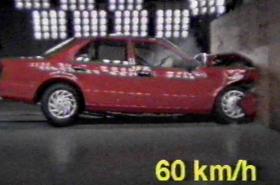
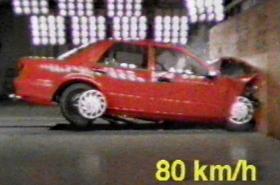
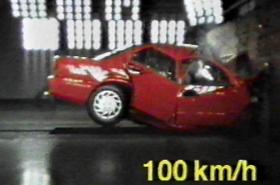
Screen shots from the Video "The
Physics of Car Crashes" by the Roads and Traffic
Authority of NSW (Marketing Dept phone 02
92186315, fax 02 92183510). These are full frontal crashes
into a rigid barrier.
An aim, then, of speed management measures
is to reduce impact speeds - preferably to zero (ie no
impact).
Stopping distances
Stopping distances are not often appreciated
by motorists. When travelling at 60km/h an alert motorist will
typically travel 25m between the time that an object becomes
visible (but not necessarily seen) and the time when
their foot hits the brake pedal. We tend to only think of
stopping distance after our foot hits the pedal!
For a given set of road conditions the
impact speed depends on the initial travel speed (Paine & Fisher 1996). Using typical
driving conditions it can be shown that the probability of a
driver fatality is highly sensitive to the initial travel
speed of the vehicle. The table shows the result of this
analysis where the distance to the hazard is 50m (alert
reaction time of 1.5s, heavy braking). Again the probabilities
are for seat-belted drivers. .
Table 2 Relationship between travel speed
and outcome for one scenario.
| Travel Speed km/h |
Impact Speed km/h |
Prob. of fatality |
Prob. of severe inj or
fatality |
| 50 |
0 (none) |
0 |
0 |
| 60 |
19 |
0 |
0.01 |
| 70 |
47 |
0.03 |
0.13 |
| 80 |
65 |
0.16 |
0.34 |
| 90 |
80 |
0.32 |
0.54 |
| 100 |
95 |
0.46 |
0.70 |
The probability of fatality of serious
injury is highly sensitive to initial travel speed - a few
km/h can make a big difference in the outcome of a crash.

This analysis supports Swedish research (Nilsson 1993) which suggests a fourth
power relationship between mean traffic speed and the
proportion of fatal crashes. A 3% reduction in mean traffic
speeds can produce a 12% reduction in fatal crashes. On this
basis measures which reduced mean traffic speeds by 2km/h in
urban areas and 3km/h in rural areas would have saved 71 fatal
crashes, 342 serious crashes and 1191 other injury crashes in
NSW during 1994.
A similar relationship between initial
travel speed and risk of fatality exists with cars hitting
pedestrians, except that, in effect, the probability of
a fatality reaches 100% at an impact speed of
60km/h (see "Vehicle
Travel Speeds and the Incidence of Fatal Pedestrian Crashes"
by Anderson, McLean, Farmer, Lee and Brooks, J. Acc Anal. and
Prev, Sept 1997)
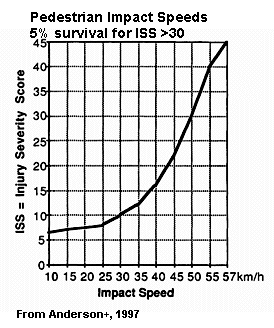
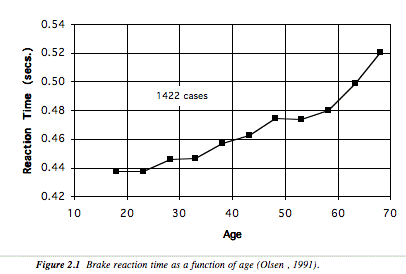
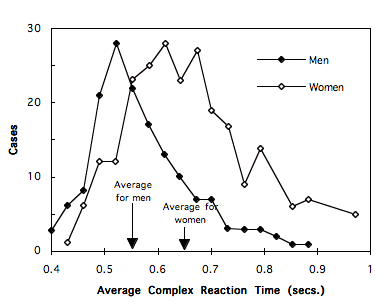
COMPLIANCE WITH
SPEED LIMITS
Compliance with speed limits
This section discusses possible voluntary
measures.
It is speculated that "unintentional"
speeding makes up a large proportion of the speeding problem
and that drivers could do with more assistance in keeping to
the speed limit. Many cars now have speed alarms or cruise
control fitted but there is currently no automatic way to
inform these devices of the posted speed limit. ITS
technologies give us the opportunity to provide roadside
devices to transmit speed limit and other information to
passing vehicles. Trials of these "automatic speed limiters"
are underway in the Swedish city of Lund (Hyden
1993) and in the Nethelands (TNO).
If the road infrastructure was in place then
the voluntary fitting of speed alarms and automatic cruise
control could become quite popular. The price would be similar
to the now-banned radar detectors and they would also help
drivers avoid fines and loss of licence!
Top speed limiting
Top speed limiting is a controversial issue.
Again, discussion will be confined to possible voluntary
measures.
There has been a recent significant change
in vehicle technology which makes top-speed limiting very
cheap.
Many cars these days have electronic engine
management systems. Most of these already have a top speed
setting but typical settings are in excess of 200km/h. It
should be relatively simple to provide a more realistic
setting - it is known that some manufacturers produce chips
with different speed settings for different international
markets.
My point is that there is a potential market
for optional speed-limited vehicles - with the appropriate
chip fitted on the production line.
A speed-limited vehicle would have the same
performance as an unlimited vehicle up to the preset speed.
However, the engine power would drop off above that speed. A
consequence is that the driver would no longer take the risk
of trying to overtake at grossly excessive speeds (Plowden & Hillman, 1984 - Plowden
also discusses alternatives to an instant drop off in power.
For example TNO in the Netherlands is currently evaluating an
actuator which increases the accelerator pedal stiffnes when a
set speed is exceeded). Speed limiting would be a strong
deterrent to theft and joyriding. And there is the issue of
teenagers borrowing the family car! In the latter case this
could be an additional application for smart keys, which
adjust the seating position according to the programmed key
which opened the door. The speed limiter could be set to the
Australian provisional driver speed limit of 80km/h.
Optional speed limiting could attract
significant insurance discounts.
Voluntary speed-limiting need not carry a
stigma. After all, Formula 1 racing drivers have resorted to
speed limiters to avoid the severe penalties of speeding in
the pit lane.
![[speed limitedin
the pit lane]](t-ee-11.jpg)
Speed-limited in pit-lane (courtesy www.f1-photos.com)
.
.
.
REFERENCES
Evans L (1993) 'Driver
injury and fatality risk in two-car crashes versus mass ratio
inferred using Newtonian Mechanics', Proceedings of 37th
Conference of Association for the Advancement of Automotive
Medicine, San Antonio, Texas.
Hyden C (1993) 'The
Speed Limiter- a Simple and Potentially Efficient Safety
Device', Proceedings of 26th International Symposium on
Automotive Technology and Automation, Aachen, Germany.
Nilsson G (1993)
'Relationship between speed and safety: calculation method', The
Speed Review: Appendix of Speed Workshop Papers, Federal
Office of Road Safety, Report CR127A, Department of Transport
and Communications, Canberra.
Paine M & Fisher A
(1996) '
Flashing Warning Lights for School Buses', Proceedings
of 15th International Conference of the Enhanced Safety of
Vehicles, Melbourne.
Plowden S &
Hillman M (1984) Danger on the road: The Needless Scourge,
Policy Studies Institute, London.
RTA (1998) Road
Traffic Accidents in NSW-1996, Statistical statements
for the years 1996 & 1994.
Disclaimer
Any views expressed in this report are those
of the author and do not reflect the views or policy of any
government agency or other organisation. It is provided on the
Internet in the interests of disseminating road safety
information. While the information presented is believed to be
accurate no assurances can be given in this regard.
Letters
- 25 Oct 03: Following
a ridiculous statement about scrapping speed cameras in my
local paper, the Manly Daily, from a local member of
parliament I wrote to the editor to point out the risk of
exceeding the speed limit. So far (a week later) the editor
has not published my letter. Here it is:
Andrew Humpherson really needs to
do his homework before calling for the scrapping of speed
cameras (MD 18 Oct). For at start he should read the
transcripts of my evidence to the Parliamentary Staysafe
Committee earlier that week.
The claim, by the British
sociology researcher, that speed cameras had not reduced the
road toll is questionable. Measuring the effectiveness of road
safety measures from the overall road toll is notoriously
difficult due to the many influencing factors. The best
way is to conduct in-depth crash investigations. Across
several continents over many years those in-depth studies show
that about half of all road fatalities occur an impact speed
of just 55km/h or less. The faster a motorist is travelling
the less chance they have of avoiding a crash and the higher
the impact speed if they do crash. This double whammy effect
means that travelling at just 5km/h over the speed limit
doubles the risk of being involved in a serious or fatal crash
(this was demonstated by road safety researchers at the
University of Adelaide in a landmark study several years ago).
Other
studies in the USA have shown that, in effect, every minute
saved by travelling in excess of the speed limit results in a
one minute loss in life expectancy across the community due to
the increased risk of a fatal crash. The community clearly
benefits from anti-speeding measures such as speed cameras.
My
main message to the Staysafe Committee was that motorists have
a false sense of safety at "normal" suburban speeds and there
is the temptation to travel faster than the speed limit.
Speeds that seem safe can suddenly turn out to be dangerous -
ask just about anyone who has been involved in a serious
crash. That is why I have suggested that motorists could do
with assistance in keeping to the speed limit through smart
technology in the car. Several trials of "Intelligent Speed
Adaptation" in Europe and Australia are exceeding expectations
in effectiveness, driver acceptance and environmental
improvement. The systems that impress me most give the driver
a simple, subtle (silent) indication that the speed limit is
being exceeded such as vibrating the accelerator pedal. In a
few years I expect that such systems will be a selling feature
of GPS navigation units in cars.
Michael
Paine
Automotive
Safety Consultant
The Manly Daily often prints
negative opinions about speed cameras but I rarely see any
attempt to verify the questionable claims that they do not
reduce the road toll. This is nonsense, as several lines of
research have shown.
Early
in April I gave a presentation on speed control at the World
Health Organisation Road Safety Day in Sydney (see link
below for a copy of my presentation). Two key points that
motorists should be aware of are:
1.
Half of all fatal accidents occur at an impact speed of less
than 55km/h. "Low speed" collisions can be deadly. This is due
to Newton's physics and the frailty of the human body.
2.
Every 5km/h above the speed limit doubles the risk of being
involved in a casualty accident. In a 60 zone, travelling at
65km/h doubles the risk and travelling at 70km/h quadruples
the risk.
For
several years I have been calling for measures that assist
motorists comply with speed limits (and, incidentaly, avoid
speeding tickets). GPS navigation technology is bringing that
closer to reality.
regards
Michael
Paine
- 8 May 04
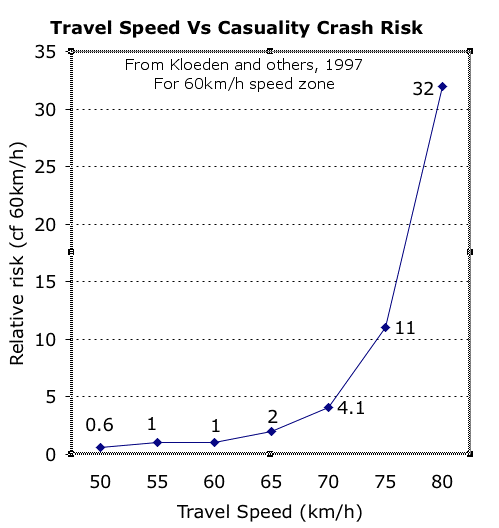
Despite his sarcasm Mr Ditmarsch
has hit the nail on the head with his comments on my letter
about speed camera. Careful research in South Australia has
shown that travelling at 80km/h in a 60 zone increases the
chances of being involved in a casualty crash by 32 times,
compared with risk when travelling at 60km/h. This is
illustrated in the attached graph, which is based on that
research. Independent research in Sweden, the United Kingdom
and the USA has come to the same conclusion.
Speed
limits are normally set according to the road and traffic
conditions, including the risk to vulnerable road users such
as pedestrians (see www.austroads.com.au). Under these circumstances, the
risk of being involved in a casualty crash while travelling at
110km/h on a freeway is roughly the same as the risk when
travelling at 60km/h on a suburban road with a 60 speed limit.
It is when the speed of the vehicle exceeds the posted speed
limit that the risk climbs dramatically.
40km/h
speed zones usually apply where there is an increased risk of
hitting a pedestrian. At an impact speed of 60km/h there is
almost a 100% chance that a pedestrian impact will be fatal.
Also in half of all pedestrian fatalities the motorist has no
chance to brake before the impact. So I agree with Mr
Ditmarsch's calculation that travelling at 60km/h in a 40 zone
would increase the risk of a casualty crash by 32 times.
In this case the most likely casualty is a pedestrian - not
himself. The problem is that, in modern cars, 60km/h in these
circumstances feels safe - but that is an illusion.
Michael
Paine
SMH 8 MARCH 2010
Safe speeding reduces road toll ... in your dreams
The Mercedes-Benz safety expert Ulrich Mellinghoff is living
in a dream world where everyone drives on speed-limitless
German autobahns in a luxury car equipped with the latest
safety features ("Fast drivers and a falling road toll:
Germans show how", March 5).
Most Australians drive cars with poor or mediocre crash
safety, and most fatalities occur on urban roads or two-lane
country roads. More than half involve crash impact speeds less
than 60km/h (even in a Mercedes).
Numerous peer-reviewed studies have shown that the fatal crash
rate is very sensitive to the speed of vehicles. Exceeding the
speed limit by just a few kilometres an hour greatly increases
the risk of a fatal crash. The recent national change to
50km/h speed limits on residential streets has resulted in a
halving of fatalities on these streets in Victoria.
Doing 70km/h in a 60km/h zone may feel safe in the modern car,
but that is an illusion. If an emergency arises, that extra
speed more than doubles the risk of a serious or fatal crash.
Recent developments with GPS technology mean it is now much
easier to drive within the speed limit at all times ˆ not just
near speed cameras. An Australia-wide speed limit advisory
function is available on some satellite navigation units that
cost less than a speeding fine. As a vehicle safety consultant
I have been evaluating these devices since 1996 but they have
been mostly ignored by the motoring media, who seem to be
immersed in the same virtual world as Mr Mellinghoff.
Michael Paine Beacon Hill





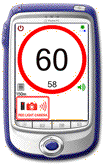







![[speed limitedin
the pit lane]](t-ee-11.jpg)
